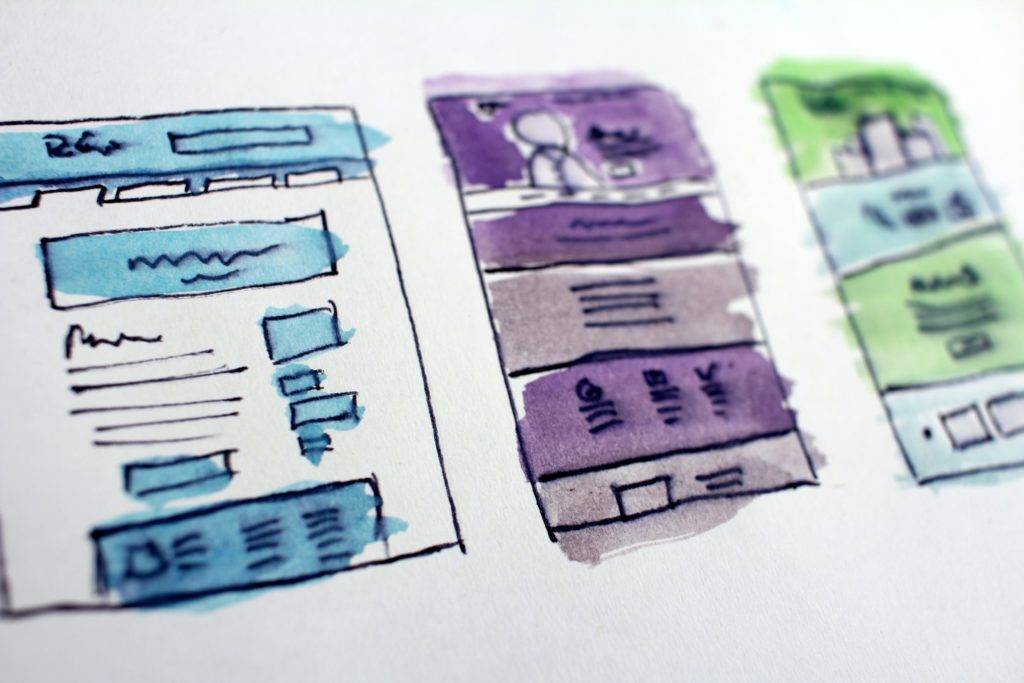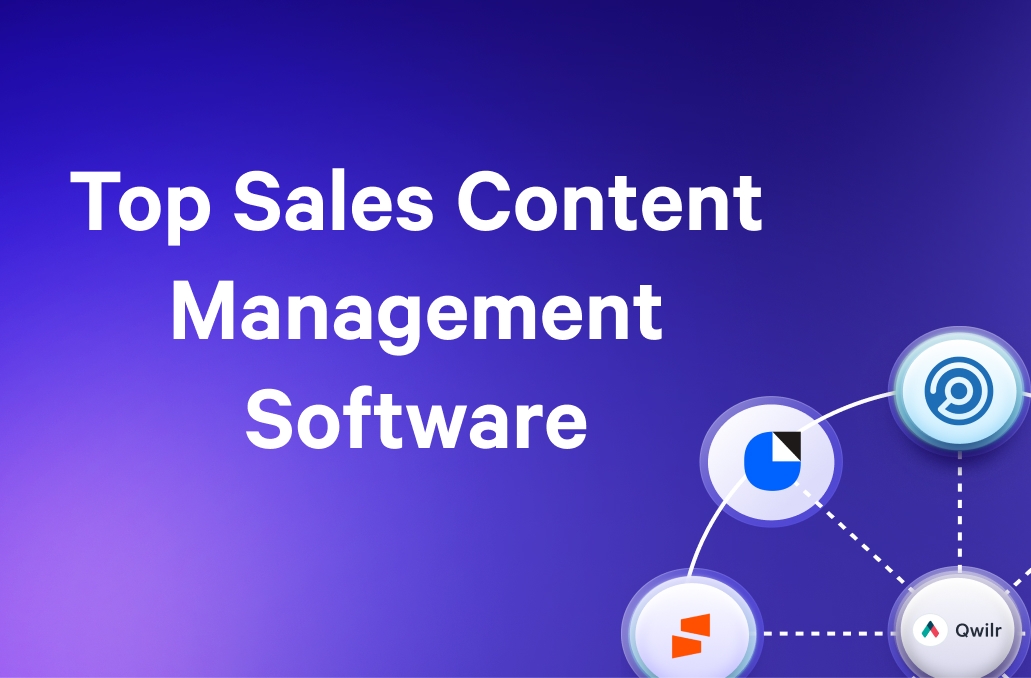Sales enablement— another buzzword or a sales strategy worth the hype? As of Dec 2023, search volume for 'sales enablement' rose 32% compared to three years earlier. This result underscores the growing interest in sales enablement.
But what about its effectiveness? Let’s look at some compelling stats.
- Hubspot’s Sales Strategy and Trends Report states that 88% of sales organizations using sales enablement find it moderately to extremely important to making a sale.
- 84% of sales reps achieve their quotas when their employer incorporates a best-in-class sales enablement strategy.
- Moreover, organizations with sales enablement achieve a 49% win rate on forecasted deals, compared to 42.5% for those without.
Impressive, right? So what makes sales enablement programs so popular? And is it worth pursuing in your organization if you haven’t done so yet?
There are many factors contributing to its success. Still, the one that remains most crucial is its ability to empower salespeople with the necessary materials, tools, and resources essential for converting leads. Ultimately, this helps them close more deals and improve their win rates; there’s an increase in sales productivity and teams can accurately forecast their sales pipeline!
But there’s more. It’s a modern method of selling that empowers not just your sales team but your prospects, too.
Want to know how this strategy can help your startup or enterprise business? Read along as we decode sales enablement, and its benefits and share a run down on where it sits in the organization.
What is sales enablement?
Well, think of it as the ultimate toolkit that’s meant to be central to your sales process and one that empowers your reps with everything they need to excel in their roles—the right materials, sales enablement software, and resources.
From top-notch training to cutting-edge technologies, sales enablement equips your team with the skills and knowledge to engage prospects, address their pain points, and ultimately close more sales deals.
In layman's terms, sales enablement is the secret sauce that supercharges your team, helping them reach new heights of sales success.
More often than not, sales reps lack basic grounding in the fundamentals of their prospect’s issues and buyer’s journey. Having access to generic content makes them (and their teams) disenchanted and frustrated.
Sales enablement changes all this by arming each rep with exceptional content that captures people's interest and provides immediate personal value to them and their potential customers. This sales enablement content goldmine makes sales reps more confident and well-researched, and valuable information helps them move the needle faster.
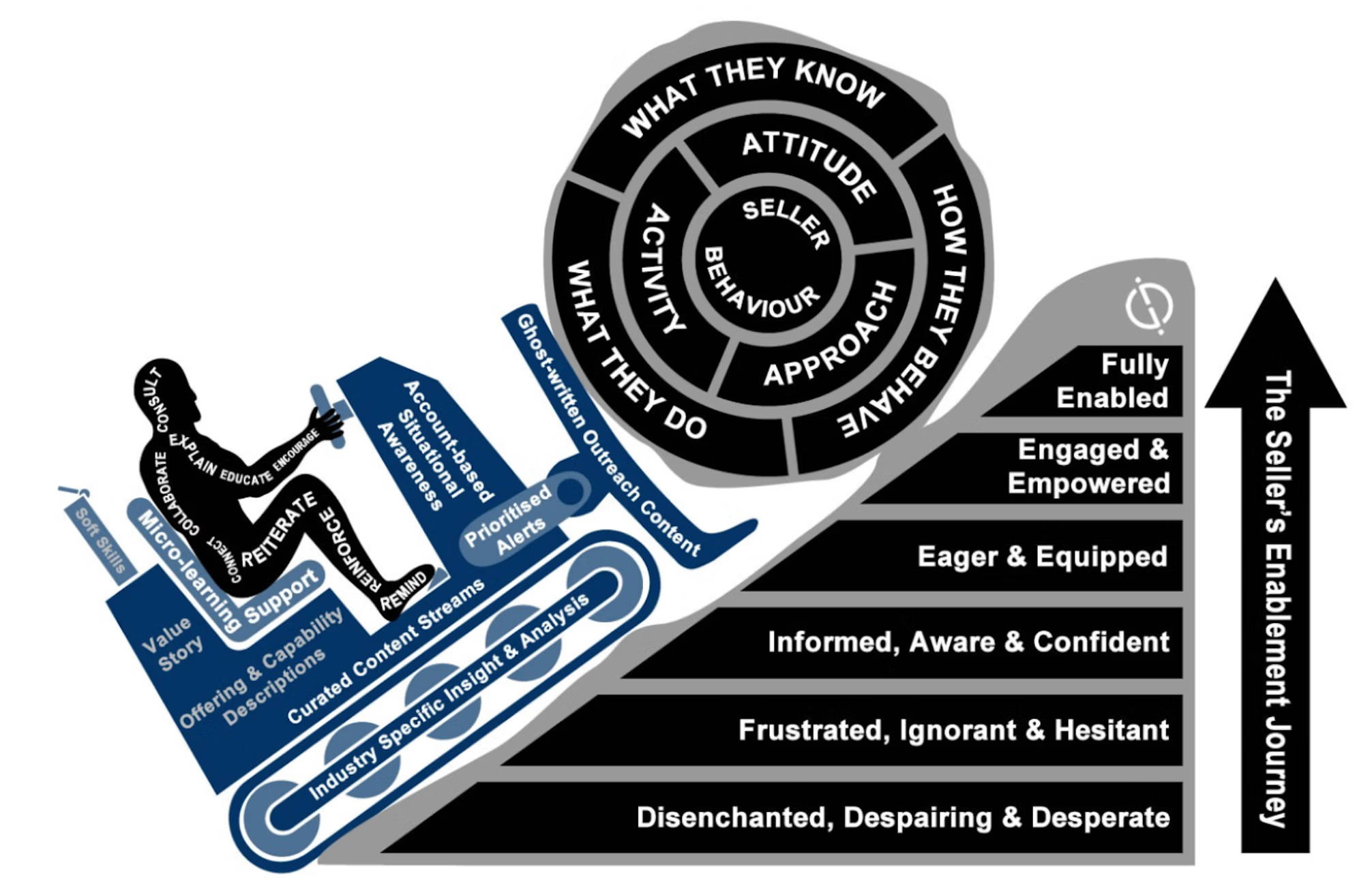
Example of sales enablement in practice
Sales enablement has many moving parts, including creating training programs and arming sales reps with market research reports, value stories, battle cards, and sales tools. This sounds like a large body of work and a huge undertaking, so how does it pan out in the real world?
Here are some of the areas of responsibility and resources a sales enablement team may be charged with and how to execute them:
Data collation
67% of sales reps mention that they can’t find relevant content to send to their prospects, so collating all the data they need is crucial. A centrally located data pool will help them quickly access reports, playbooks, customer-facing information, and documents when in need and ignite powerful sales conversations.
The sales enablement team might be charged with creating an internal Wiki or knowledge database (using software like Guru or a sales enablement platform) and can support sellers' proposal efforts with research and custom data analysis needed to win deals.
Internal content and external content
When it comes to sales enablement, having the right internal and external content is vital to helping your sales team shine. Internally, we're talking about game-changing, ready-to-go email templates, one-pagers, battle cards, and sales scripts. Plus, when it comes to overcoming sales objections that sellers face during the sales process - the sales enablement team can provide crucial support through resources to help sellers overcome some of the most common and easily navigate tricky situations to make the buying process much easier for prospective customers.
External content such as blogs, whitepapers, and customer success stories also play an essential role in eliminating prospects' objections, adding value, and differentiating your sellers from the crowd. The sales enablement team may coordinate the creation of some of these documents or partner with colleagues on the marketing team.
Training & coaching
When it comes to boosting the effectiveness of your sales team, it's not just about providing them with information. It's also about identifying the specific skills and methods that can take their performance to the next level, and that’s where sales training can help.
The sales enablement team might be charged with creating a formal sales training program, but they may also be able to provide upon request sales coaching sessions. These sessions can focus on effective sales processes, teaching your reps how to make the most of sales enablement tools and showing them the ropes of preparing, analyzing, and utilizing data to gain valuable insights.
If your sales team uses a specific methodology to sell, the enablement team might also coordinate with outside trainers or participate in train the trainer sessions to get certified to conduct training sessions and certify sellers in that particular methodology.
The other place sales enablement professionals can support training and coaching is to partner with sales leadership to recognize high-potential sellers and help with career development resources so that these team members are able to grow their careers within the organization.
Optimization of existing technology
The right sales tools can work wonders and transform your sales enablement strategy, but you must choose them wisely. Tools that don't align with your sales team enablement goals can end up being more of a hindrance than a help.
From CRMs to sales enablement software like Salesloft, Highspot, and their many competitors and even business intelligence, email outreach, and social selling tools, there are so many ways organizations can invest their budgets in sales enablement. But, as we know, the tools are only as good as they’re being leveraged. So it’s part of the role of the sales enablement team to optimize the sales tech stack and ensure the budget is being invested wisely. This may mean regular audits of the current tools and time to explore new or improved offerings as they hit the market.
Defining metrics for measurement
Lastly, by keeping a close eye on the right metrics and KPIs and displaying them in a user-friendly way, sales enablement helps your sales team unlock invaluable insights. These insights reveal what captivates your audience and brings in those wins.
The sales enablement team might create dashboards for sellers and sales leaders so they can understand the most important sales enablement KPIs and the team’s progress against them. Furthermore, they might work with sales leadership to make business decisions and adjust the sales strategies or tactics based on what the data is showing. This is why data analysis is a key skill for sales enablement professionals
What are the benefits of introducing a sales enablement function?
The benefits of introducing sales enablement at your organization are plenty. From prospecting to closing, it can elevate all sales cycle stages.
Let’s look at some core benefits of this functional group.
Increased sales productivity
As a sales leader, you expect your reps to have enough time to sell, yet nearly two-thirds (64.8%) of reps’ time, on average, is spent on non-revenue-generating activities leaving only 35.2% for functions related to selling.
It's a productivity drain when reps feel like they're spinning their wheels. Just think about the friction caused by continuously looking for the right content that can help them close deals faster. Time is precious, and your sales reps know it too.
They want to spend less time on tedious admin tasks and more time doing what they do best. That's where sales enablement can help—armed with content, tools, and processes to automate those admin tasks with ease. It's all about boosting efficiency and making your reps genuinely productive.
Advanced sales and marketing alignment
With sales enablement, your sales and marketing teams can collaborate more effectively. By connecting strategies, campaigns, and goals, you'll drive revenue and create a seamless collaboration between the two departments. For example, a B2B SaaS company can align marketing's lead generation efforts with sales outreach strategies, resulting in a more effective and coordinated approach.
Effective communication between marketing and sales is vital, and sales enablement facilitates this alignment. When everyone is on the same page, reps can confidently deliver messaging that aligns with what marketing has presented to customers. This consistency builds trust with your audience and enhances the overall customer experience, which is crucial for any business.
Forecast improvement
Is your organization constantly second-guessing the future revenue from your team, and how many reps will attain quota each month? Data shows that 57% of sales teams inaccurately forecast their pipeline due to poor sales processes.
However, sales enablement can level up your forecasting game. By leveraging engagement tools, implementing effective sales processes, and harnessing the power of data insights, sales enablement takes your forecasting accuracy to a whole new level, significantly improving sales performance. And who doesn’t want more predictable revenue and more accurate forecasts?
Better sales velocity
Sales reps spend an average of 440 hours each year trying to find the right content to share with their prospects and customers. A lot of this time is spent on just researching!
Sales enablement empowers reps with a repository of ready-to-use sales content. It means more face time with prospects and increased efficiency in the sales process for your company. By enabling sales reps to sell more frequently, they can ramp up their sales velocity and accelerate the pace of deals.
Improved customer focus
With sales enablement, reps can easily access external-facing content their prospects are interested in. This allows them to better understand their audience's needs and interests, tailoring their approach and providing real value during interactions. This can lead to stronger connections with potential customers and higher conversion rates, especially in the SaaS space.
What defines the top 1% of sales enablement functions?
If your goal is to succeed with sales enablement, know that it takes a good strategy, the whole company coming together, and strong leadership to win, but there’s more to it. Most companies that succeed with sales enablement have a few things in common.
A well-laid-out sales enablement charter
Before implementing a company-wide sales enablement strategy, it’s crucial to have a well-defined yet flexible charter.
What’s a sales enablement charter, you ask?
Aimee Roberson, Revenue Enablement Director at Assent, explains it:
“If you break it down to its most basic intention, a charter is your plan for how you're going to move ahead with enablement. Whether it's a new discipline or if you're evolving it. And the intent is also to bring everybody along with you so they understand where they participate, where they play, where they're accountable so that you can be successful on the other side.”
While Aimee’s advice may sound like a no-brainer, this step is often overlooked or not given the time it deserves by companies, resulting in miscommunication and similar bottlenecks. A documented charter, on the other hand, gets everyone on the same page, clearly outlines the expectations, and removes any ambiguity.
A few critical components of the charter include:
- A mission statement
- Key goals and initiatives
- The team involved and the ownership structure
- Who owns the budget
- Success metrics
However, do remember that a charter will be unique to your organization. Here’s a sample charter that you can use for inspiration to build your own.

Consistent cross-department communication
Successful sales enablement initiatives rely on seamless alignment with other departments. Think of sales managers and reps, leaders, marketing teams, trainers, designers, and more.
This is where the importance of having a communications plan to create alignment truly shines. While each group shouldn’t be overwhelming the others with updates, you do want to ensure you have a plan to keep everyone in the loop. This might look like a schedule of regular email updates and interdepartmental meetings like an all-hands or a town hall. These meetings will not just foster a collaborative environment; they will allow others in the team to share insights, best practices, and data-driven perspectives.
For instance, when your sales team collaborates closely with the marketing department, they can jointly refine buyer personas, optimize content, and synchronize messaging. Moreover, meetings with the product development team facilitate the introduction of feature enhancements based on sales feedback, further empowering your sales reps to address customer pain points more effectively.
Again, having a meeting for the sake of it isn’t going to take you further, so ensure that these are penciled in the calendar for a time frame that’s ideal for your company and teams approach it with an agenda. Jaren Krchnavi, Global Head of Sales Enablement at Siemens, also shares an important tip for conducting these meetings effectively.
He states,
“Identify key people who will give you invaluable feedback and be sales enablement champions within the organization.”
Remember that these meetings needn't be formal; you can do them in a lunch-and-learn style to keep things informal and accessible.
Clear team structure
One of the significant challenges with sales enablement is the lack of clear insights into who owns what, and that’s where a clear and well-defined structure can help things move in the right direction.
Of course, this will vary from one organization to another and is tied to many factors such as company size, product complexity, budget, market dynamics, and more, but a barebone structure should consider looks like this:
- Sales and marketing managers for alignment across both teams
- A dedicated sales enablement professional (ideally a manager) to streamline your sales enablement process
- A customer success manager to help teams understand customer pain points, evaluate strategies' effectiveness, and brainstorm collaterals to simplify onboarding and upselling.
Talking about sales enablement org design, Elay Cohen, co-founder of SalesHood, a SaaS sales enablement platform and community for sales professionals, says:
“The success of the sales enablement team depends on the individuals you have chosen to lead the teams and be responsible for its performance. You have to match the tasks with the leader’s understanding of goals, priorities, best practices, and company needs.”
Where does sales enablement sit in the org?
Data by G2 found that 77.1% of companies with a sales force exceeding 500 people have dedicated sales enablement, compared to 39.3% of companies with 25 or fewer, which, in a way, is an indicator that to be able to see the best results, sales enablement is ideally suited for companies at a particular growth stage.
If you’re a company seriously considering implementing this strategy, you must know who owns the function and where sales enablement sits in your organizational structure. While it is abundantly clear that sales and marketing own the function, the roles within a sales enablement function can sometimes feel like a mystery as it is still in its infancy.
Unlike the clearly defined functions of marketing or sales operations, sales enablement expectations can differ depending on factors like company size, how the sales organization is structured, and what the stakeholders prioritize.
So, while the expectations may vary, the goal remains the same: to empower your sales team and drive results. Let’s evaluate two job roles to understand this better:
1. Job 1: Sales Enablement Manager - Business & Payments at Xero
This role advertised by Xero, a global unicorn with over 5000 employees, highlights that the sales enablement manager, in this role, would be responsible for empowering Xero's sales team to achieve performance targets and would be required to work with several regional sales enablement managers to deliver a payment focused learning agenda in the region.
It’s also somewhat given that in this role, instructional designers and coordinators would be responsible for executing the tactical elements while the managers would handle implementing initiatives.
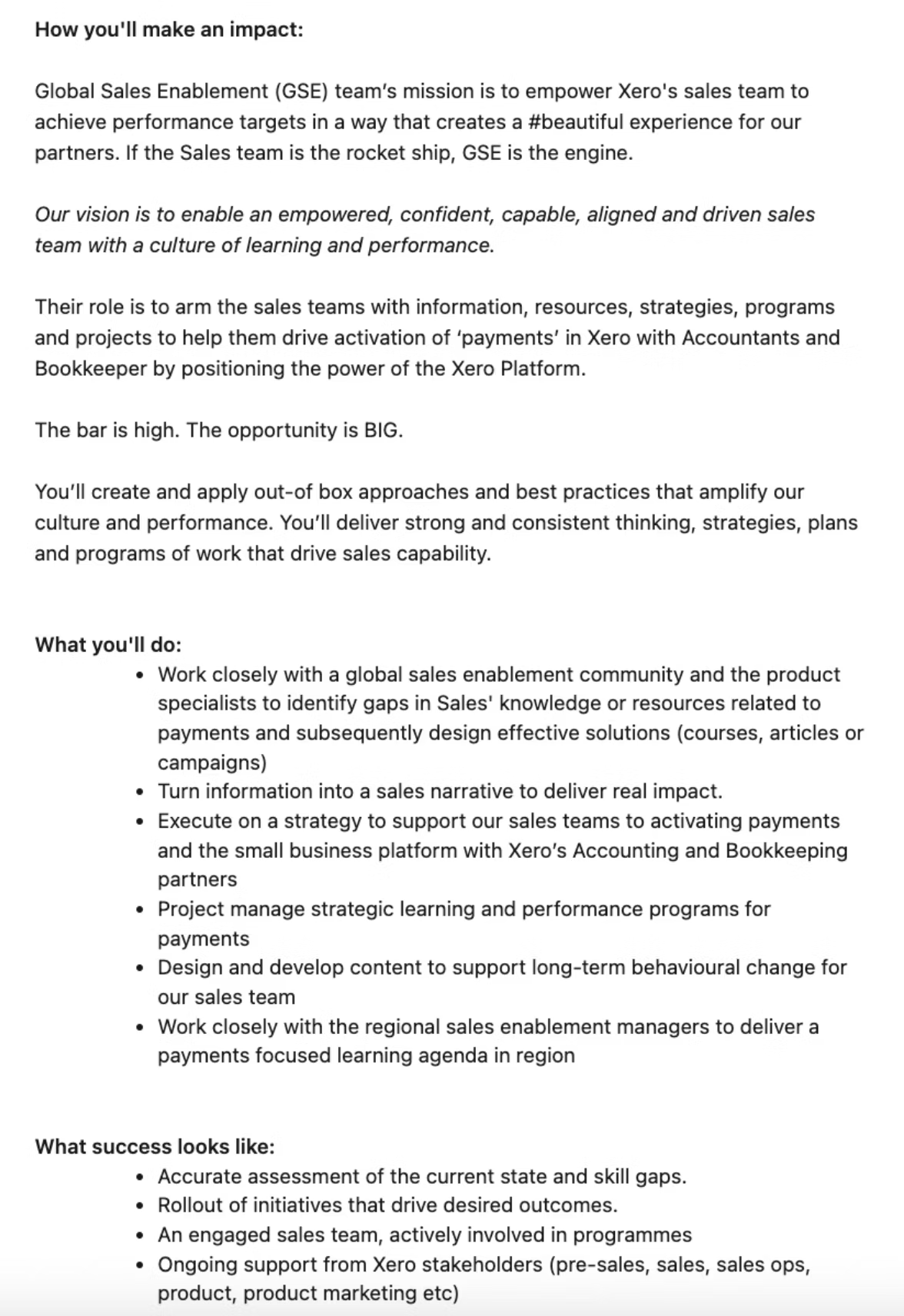
2. Job 2: Sales Enablement Manager -Kustomer
In this second role advertised by a relatively smaller organization (500 employees), Kustomer sales enablement manager would report to the VP of sales.
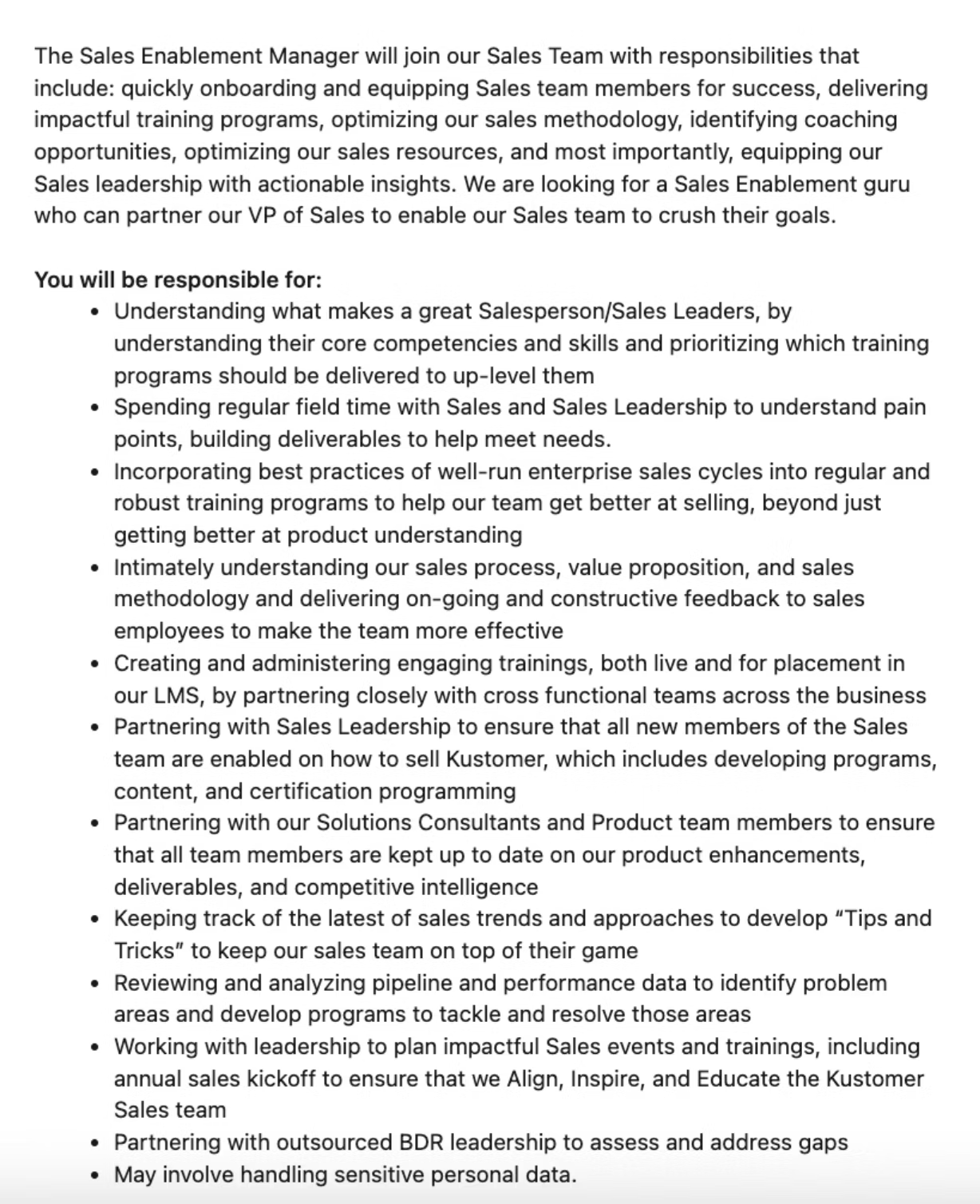
Given that the company might not have a junior staff to support the manager, it feels like a role that would require one to wear many hats, collaborating cross-functionally and being responsible for implementation and the development and design of content.
Whether you're a small startup, a growing mid-sized company, or a well-established enterprise, sales enablement can be customized to support your specific needs and align with your stakeholder priorities. The key things to know here are to be on the same page about stakeholder priorities, the bandwidth of the team, and the goals that need to be achieved.
How should you think about building your sales enablement stack?
When it comes to sales enablement, choosing the right tools is like finding the perfect sidekick for your sales team. Your enablement stack, therefore, will vary with your company’s unique set of needs, goals, and challenges. What works for one company might not necessarily work for another.
That’s why it is advised that you take the time to evaluate different options, consider demos and trials, and involve key stakeholders to ensure that the chosen tool aligns perfectly with your organization's objectives and processes.
For example, sales reps value enablement tools that allow them to easily organize and access sales enablement collateral, whereas for sales enablement managers, tools that offer robust analytics and insights are more useful as they help them identify areas for improvement and tailor content for maximum impact.
When building your sales enablement stack, think of the following:
Customization for your unique needs
Sales enablement tools come in various shapes and sizes, offering different features and functionalities. Selecting a tool that can be customized to your organization's specific needs will ensure it fits seamlessly into your existing workflows and supports your unique sales processes. For example, a startup might prioritize simplicity and ease of use, while a large enterprise might require advanced analytics and robust integrations.
Scalability and growth
As your organization grows and evolves, so will your sales enablement requirements. Choosing a tool that can scale with your business ensures you won't outgrow its capabilities too quickly. Whether you're expanding into new markets or increasing your sales team’s headcount, having a flexible tool that can adapt to changing needs will be a valuable asset.
Integration and collaboration
Consider how the sales enablement tool integrates with your existing tech stack. Seamless integration with your content management tools, CRM, marketing automation, or other relevant systems can streamline processes and facilitate data sharing.
Additionally, think about how the tool promotes collaboration among your team members, allowing them to share best practices, collaborate on content creation, and stay aligned on sales enablement strategies. For example, Qwilr’s proposal software comes armed with integrations and makes it extremely easy for sales reps to spin a proposal in minutes.
User-Friendly Interface and Adoption
A user-friendly tool increases adoption rates among your sales team. Look for an intuitive interface, easy navigation, and clear instructions to minimize the learning curve and ensure quick adoption. When your reps find the tool easy to use and see its value in enhancing their productivity, they will be more motivated to embrace it.
FAQs
What is the difference between sales enablement and marketing?
Sales enablement empowers the sales team with the right tools, resources, and knowledge to engage prospects, overcome challenges, and successfully close sales deals. On the other hand, marketing focuses on attracting, educating, and nurturing leads through various channels to create brand awareness and interest.
While sales enablement directly supports the sales team's efforts, marketing plays a critical role in generating and qualifying leads before they reach the sales stage.
What are the key pillars of sales enablement?
There are four key pillars of sales enablement which include:
- Adequate training and continuous development- provide sales reps with the necessary skills and knowledge to engage prospects and close deals.
- Access to impactful sales content, such as sales scripts, presentations, and case studies, enables reps to deliver persuasive messages and build strong customer connections.
- Advanced sales technologies, like CRM integration and sales automation tools, streamline processes and boost productivity.
- Data-driven insights and analytics offer valuable information to make informed decisions and fine-tune sales strategies.
By prioritizing these key pillars, organizations can unleash the full potential of their sales teams and achieve remarkable results.
Final Thoughts
Sales enablement is not only valuable but utterly indispensable, especially with the ever-shifting customer behaviors. As competition intensifies, incorporating sales enablement into your organization’s growth plan can be a game changer.
Yes, it is a lot of work, but it is worth seeding it now to reap its benefits and drive some serious growth for your organization. Before you take the next steps, remember sales enablement hinges on a solid strategy, buy-in from the entire team, and good governance.
And once implemented, use our sales velocity calculator to see how quickly deals move through your pipeline and generate revenue, indicating overall business health and sales effectiveness!
About the author

Brendan Connaughton|Head of Growth Marketing
Brendan heads up growth marketing and demand generation at Qwilr, overseeing performance marketing, SEO, and lifecycle initiatives. Brendan has been instrumental in developing go-to-market functions for a number of high-growth startups and challenger brands.



